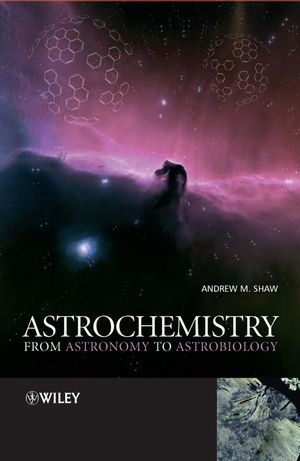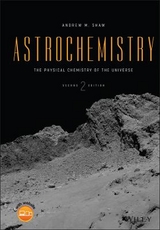
Astrochemistry
John Wiley & Sons Inc (Verlag)
978-0-470-09136-4 (ISBN)
- Titel erscheint in neuer
- Artikel merken
includes latest research and results from ground and space missions
colour plate section
summary of concepts and calculations at the end of each chapter
accompanying website www.wiley.co/go/shawastrochemistry
This book will be an ideal text for an undergraduate course in Astrochemistry and an essential tool for postgraduates entering the field.
Andrew M. Shaw, University of Exeter, UK.
Preface. 1The molecular universe.
1.1 The Standard Model Big Bang Theory.
1.2 Galaxies, stars and planets.
1.3 Origins of life.
1.4 Other intelligent life.
1.5 Theories of the origin of life
Concepts and calculations.
2 Starlight, galaxies and clusters.
2.1 Simple stellar models–black body radiation.
2.2 2.726 K–cosmic microwave background radiation.
2.3 Stellar classification.
2.4 Constellations.
2.5 Galaxies.
2.6 Cosmology.
Concepts and calculations.
Problems.
3 Atomic and molecular astronomy.
3.1 Spectroscopy and the structure of matter.
3.2 Line shape.
3.3 Telescopes.
3.4 Atomic spectroscopy.
3.5 Molecular astronomy.
3.6 Molecular masers.
3.7 Detection of hydrogen.
3.8 Diffuse interstellar bands.
3.9 Spectral mapping.
Concepts and calculations.
Problems.
4 Stellar chemistry.
4.1 Classes of stars.
4.2 Herzprung–Russell diagram.
4.3 Stellar evolution.
4.4 Stellar spectra.
4.5 Exotic stars.
4.6 Cycle of star formation.
Concepts and calculations
Problems.
5 The interstellar medium.
5.1 Mapping clouds of molecules.
5.2 Molecules in the interstellar and circumstellar medium.
5.3 Physical conditions in the interstellar medium.
5.4 Rates of chemical reactions.
5.5 Chemical reactions in the interstellar medium.
5.6 Photochemistry.
5.7 Charged particle chemistry.
5.8 Polycyclic aromatic hydrocarbons.
5.9 Dust grains.
5.10 Kinetic models of molecular clouds.
5.11 Prebiotic molecules in the interstellar medium.
Concepts and calculations.
Problems.
6 Meteorite and comet chemistry.
6.1 Formation of the solar system.
6.2 Classification of meteorites.
6.3 Meteorite mineralogy.
6.4 Geological time.
6.5 Chemical analysis of meteorites by µL2MS.
6.6 The Murchison meteorite–kerogen.
6.7 Meteorite ALH84001.
6.8 Comet chemistry.
6.9 Structure of a comet.
6.10 Physicochemical conditions in a cometary coma.
6.11 Chemical composition of comets.
6.12 Cometary collisions.
6.13 The Rosetta mission–origin of the solar system.
Concepts and calculations.
Problems.
7 Planetary chemistry.
7.1 Structure of a star–planet system.
7.2 Surface gravity.
7.3 Formation of the Earth.
7.4 Earth–Moon system.
7.5 Geological time.
7.6 Radiative heating.
7.7 The habitable zone.
7.8 Extrasolar planets.
7.9 Planetary atmospheres.
7.10 Atmospheric photochemistry.
7.11 Biomarkers in the atmosphere.
Concepts and calculations.
Problems.
8 Prebiotic chemistry.
8.1 Carbon- and water-based life forms.
8.2 Spontaneous chemical reactions.
8.3 Rates of chemical reactions.
8.4 Endogenous production of organic molecules.
8.5 Exogenous delivery of organic molecules.
8.6 Homochirality.
8.7 Surface metabolism–'clay organisms'.
8.8 Geothermal vents–'black smokers'.
8.9 RNA World hypothesis.
Concepts and calculations.
Problems.
9 Primitive life forms.
9.1 Self-assembly and encapsulation.
9.2 Protocells.
9.3Universal tree of life.
9.4 Astrobiology.
9.5 Microbial Mars.
Concepts and calculations.
Problems.
10 Titan.
10.1 Physical properties.
10.2 The atmosphere.
10.3 Temperature-dependent chemistry.
10.4 Energy balance and the greenhouse effect.
10.5 Atmospheric chemistry.
10.6 Astrobiology on Titan.
Concepts and calculations.
Problems.
Glossary of terms and abbreviations.
Appendix A: constants and units.
Appendix B: astronomical data.
Appendix C: thermodynamic properties of selected compounds.
Answers to problems.
Bibliography.
Index.
| Erscheint lt. Verlag | 16.6.2006 |
|---|---|
| Verlagsort | New York |
| Sprache | englisch |
| Maße | 168 x 244 mm |
| Gewicht | 822 g |
| Themenwelt | Naturwissenschaften ► Chemie |
| Naturwissenschaften ► Physik / Astronomie ► Astronomie / Astrophysik | |
| ISBN-10 | 0-470-09136-3 / 0470091363 |
| ISBN-13 | 978-0-470-09136-4 / 9780470091364 |
| Zustand | Neuware |
| Informationen gemäß Produktsicherheitsverordnung (GPSR) | |
| Haben Sie eine Frage zum Produkt? |
aus dem Bereich



